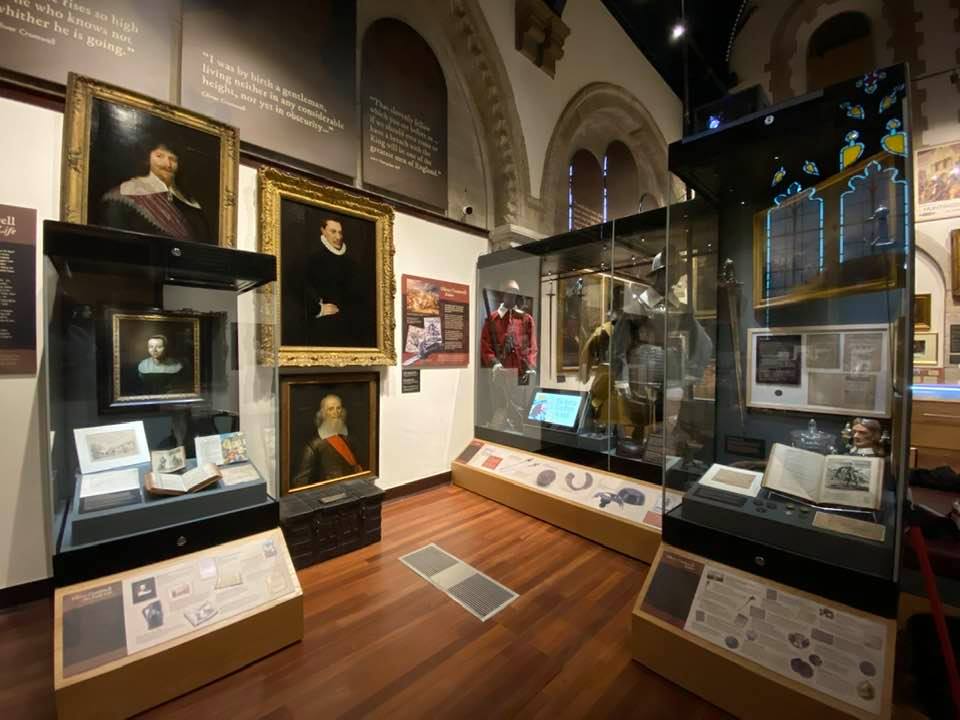Stay in touch with the latest news from AIM and get information on sector grants, jobs and events with our free fortnightly E-News.
Pilgrim Trust Conservation Grant – Conserving Cromwell

The Cromwell Museum tells the story of the life and times of the soldier and statesman Oliver Cromwell (1599-1658) through the best collection of items relating to him. Founded in 1962 we are an independent charity with one member of staff (our curator) and a team of some 50 volunteers. We are located in a small medieval building (the former grammar school which Cromwell attended) in the heart of his hometown of Huntingdon.
Through the winter of 2019/20 the Museum underwent a major refurbishment (the first in over 30 years), with a grant from the AIM/BIFFA ‘History Makers’ Scheme as part of its core funding. One of the aims of this project was to highlight key objects from our internationally important collection, and we wanted to take the opportunity to conserve three of our most significant portraits.
We asked Polly Saltmarsh, conservator, to do an appraisal of the state of our portraits and identify those that would most benefit from conservation. From these we selected three portraits to conserve:
- Portrait of Oliver Cromwell by Robert Walker, Oil on canvas, c.1649. This is the largest and most valuable portrait in our collection and is a unique full length, life sized study of Cromwell in flamboyant garb. Prior to refurbishment this was mounted high up where it was difficult to see and had gathered dust. We wanted instead to have it as a statement object as visitors enter the Museum.
- Portrait of Sir Oliver Cromwell by Hieronimo Custodis, oil on board, c.1580. This is the oldest portrait in our collection, depicting Cromwell’s uncle and namesake. This portrait was of most concern and is very dark for the visitor to distinguish detail.
- Equestrian portrait of Oliver Cromwell, English School, c.1657. A rare portrait of Cromwell on horseback, depicting him in a silk suit with pre-Great Fire London in the background, which is a favourite item for visitors.
The large portrait of Cromwell received the most extensive treatment, in light of the significance to be placed on it as part of the refurbished displays. It was carefully cleaned, later layers of darkened varnish and overpaint removed, retouching applied where required and the framing adjusted as needed. This work has not only ‘lifted’ the painting, it has revealed many more unseen details of Cromwell’s clothing and the background landscape.
The portrait of Cromwell’s uncle has been stabilised to reduce the buckling that was taking place between its panels, providing better support; treatments were applied to reduce the reflectiveness of the varnish, making the painting easier to read, and retouching applied. Long term it may need further conservation, but it has improved the painting significantly and stabilised its condition.
The equestrian portrait of Cromwell was gently cleaned, stabilised and retouched as required.
All three items now form a significant part of the Museum’s newly refurbished displays, which were reopened to the public on 1st March 2020. The life sized portrait by Walker forms a particular impact point being opposite the entrance, protected by a large case which is inscribed with various descriptions of Cromwell (positive and negative) and creates a real ‘wow’ factor for visitors as they arrive and are confronted by him. Interestingly (and although we have had to close for the Coronavirus outbreak like everyone else) already visitors seem to like using this as a point for selfies too – although whether they are all ‘warts and all’ is open to debate!
Stuart Orme, Curator
